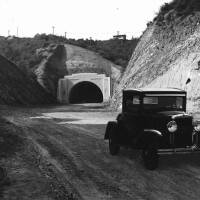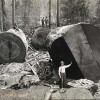Concrete Fantasy: When Southern California's Freeways Were New (And Empty)

Union Bank is a proud sponsor of Lost LA. 
The Southland's freeways hardly inspire optimism anymore. Glance at the shoulder of a slow-moving freeway and among the weeds you'll see shards of plastic and twisted metal – the accumulated detritus of a dozen high-speed crashes. They may (occasionally) be convenient, but whether it's their shabby appearance, the way they displaced a quarter-million people, or simply their soul-crushing traffic, it's hard to feel good about the freeways. We consider the profound social and environmental costs of our freeway system in tonight's episode of "Lost L.A."
Freeways once represented the Southland's best hope for the future.
But there was a time when Southern California's freeways were new, and feelings were different. Despite local opposition to specific routes, the freeway system as a whole enjoyed widespread political support. L.A.'s infatuation with the automobile hadn't yet waned, so it was only natural for the city to embrace these new monuments to car culture. They provided an alternative to the aging electric railways and traffic-choked boulevards. They promised to improve life in the decentralized city. They represented the region's best hope for the future.
The photographs here – many of them produced for publication in the Los Angeles Times, Examiner, and Herald Express – reflect the unbound optimism of the time. Sure, the concrete is freshly poured, the landscaping is trimmed, and the shoulders are free of debris, but the images themselves represent a deliberate celebration of the freeway. Their composition emphasizes open pavement and gently curving lines, implying speedy and graceful travel. And in many of the images, the freeway lanes fill the frame at the expense of the surrounding landscape – a subtle but reassuring message that these superhighways have conquered the long distances of the famously sprawling region.














This article originally appeared on Gizmodo's Southland subdomain on April 25, 2014. It has been re-published here in conjunction with the airing of Lost L.A.'s "Building the Metropolis" episode.










